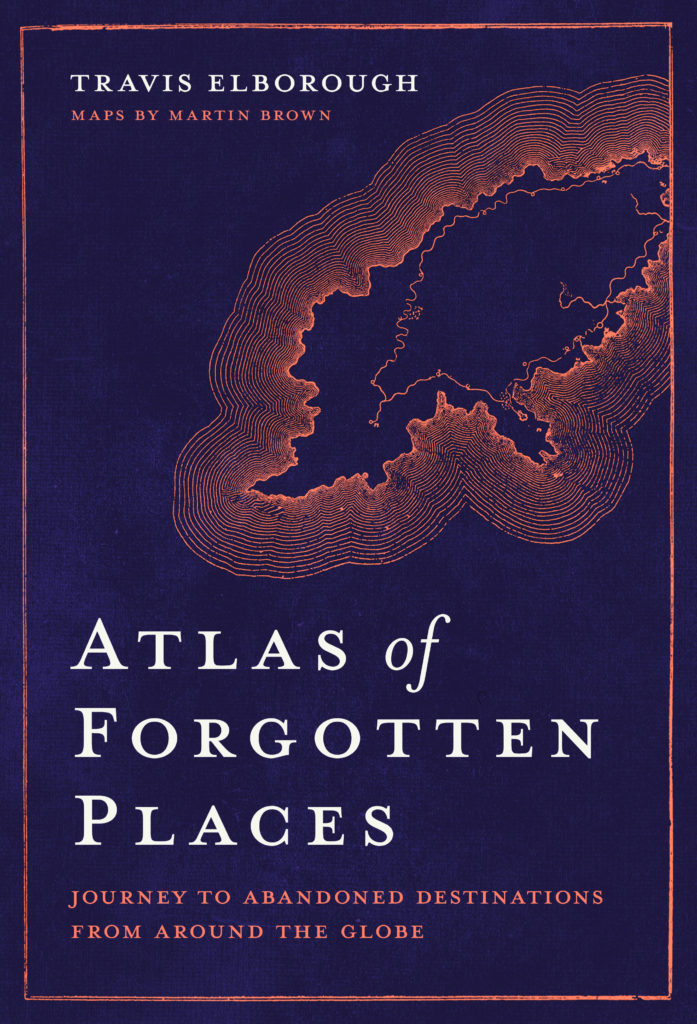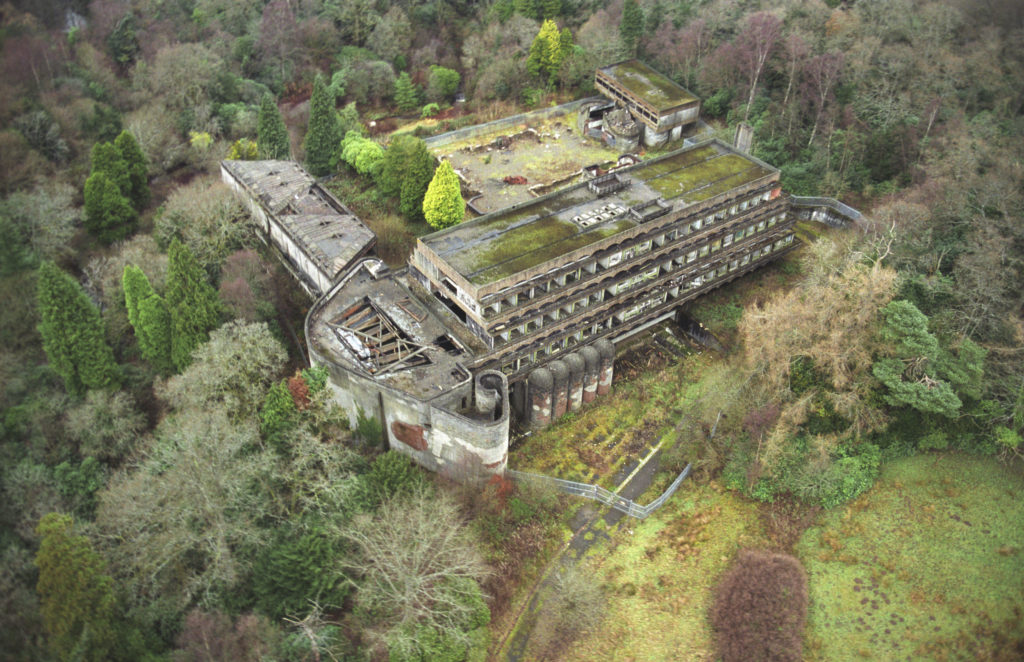In an extract from ‘Atlas of Forgotten Places: Journey to Abandoned Destinations From Around the Globe’, Travis Elborough considers Cardross’s decaying Brutalist seminary.

ST PETER’S SEMINARY COLLEGE CARDROSS, SCOTLAND, UK 55° 58′ 13.03″ N / 4° 38′ 26.65″ W
Robert the Bruce, locals are surprisingly proud to point out, died of leprosy in these parts. Until the foundations of his palace were finally excavated a little further to the east under fields at Pillanflatt in Renton on the River Leven in 2009, they would usually point with a flourish to the ruins of the medieval Cardross Castle and swear it happened here. Historians have always known rather more about the Scottish king’s final years than his origins. The precise date and place of birth of this bester of the English at the Battle of Bannockburn in 1314 are much disputed, with even Writtle in Essex claimed over Turnberry in Ayrshire as the more likely location. But it was in the Manor of Cardross, which in Scots Gaelic means ‘a curved headland’, that Bruce settled in the last three years of his life. It was also where, in between sewing up treaties with France and England to shore up Scotland’s independence, the increasingly sickly king retreated to hunt, hawk and sail on the Firth and fish in the Leven. Before expiring in these pleasant surroundings ‘on or about the third week of June 1329’, Bruce supposedly requested that his heart be taken to Jerusalem to fulfil the vow he’d made earlier in his reign to undertake a crusade to the Holy Land. Legend has it that this sacred mission was carried out by his most trusted lieutenant Sir James Douglas, who was then slain in a battle against the Moors. Both Douglas’ bones and Bruce’s heart (which the knight carried in a silver urn worn on a necklace) were returned to Scotland for burial. Such piety was to result in Bruce’s earthly remains being divided. The bulk of his body was laid to rest at Dunfermline Abbey; his heart wound up at Melrose Abbey in Roxburghshire – a revered Cistercian monastery that Bruce had had rebuilt following its partial destruction by the English king Edward II in 1322.
That over 600 years later, an institution of Catholic religious instruction would be erected within the environs of Bruce’s former estate at Cardross, might have pleased the god-fearing, if briefly papally ex-communicated, king. That it should, however, have fallen into ruinous decay within just a few decades of its construction perhaps rather less so. When it first opened its doors in 1966, few could have pictured St Peter’s Seminary College as a ruin. It looked like the future. So much so that seminarians jokingly referred to it as ‘the spaceship’. Even today, in appalling decrepitude, its buildings continue to sing of a recent past where the outlook was more determinedly and boldly futuristic. The Catholic church at the time, responding to the changes being wrought across post-war society by advances in science, medicine and technology, was itself embarking on a period of modernization. The Second Vatican Council, announced in 1959 and first convened in 1962, was to lead to changes to the liturgy to encourage greater participation by worshippers and allowed Mass to be celebrated in vernacular languages rather than simply in Latin. St Peter’s was a child of those times, one of a series of strikingly modern ecclesiastical buildings that included churches at Glenrothes, Dennistoun, Drumchapel, Kilsyth, Duntocher, Easterhouse, Cumbernauld and East Kilbride. These were produced for the Roman Catholic Church in Scotland by Andrew MacMillan and Isi Metzstein of the Glasgow-based architectural practice of Gillespie, Kidd & Coia.
Neither man was Catholic: MacMillan was a lapsed Presbyterian and Metzstein, a Berlin-born Jewish exile. The design of St Peter’s was partially inspired by another Marian building, the austerely beautiful Brutalist Dominican Monastery of Sainte-Marie-de-La-Tourette at Eveux-sur-Arbresle, outside Lyon in France and the work of the high priest of architectural modernism, Le Corbusier. As a training college for novice Catholic priests, St Peter’s was built to accommodate just over a hundred seminarians, and featured living quarters, a refectory, a library, lecture theatres and a chapel. The chapel, conceived ‘as the kernel of the complex’, was at its centre, putting the sacred at the very heart of the structure – a detail that led the architectural historian Dr Patrick Nuttgens to hail it as a ‘house of god where living, contemplation and working all combine in a single act of worship.’ The seminarians themselves praised it in the pages of their college magazine. ‘There is’, one wrote, ‘a dignity and spaciousness in its great areas, like the chapel and refectory, that bring a feeling of great contentment to the heart.’

An aerial view of the seminary building shows the scale and extent of decay at the site. Picture: Tom Kidd/Alamy Stock Photo
The building, nevertheless, wasn’t without its flaws, though most were the result of shoddy construction rather than matters of design per se – in particular, ill-fitted doors and windows that left it prone to leaks when it rained. What proved more fatal to its long-term prospects was a decline in the fortunes – financial and cultural – of the Catholic church in Scotland and new ideas of how priests should be trained. The college at its peak occupation only attracted fifty-six students. This meant its facilities were, effectively, always half empty at best and its capacious lecture theatres especially were felt to be far too roomy for comfort. The whole complex was costly to service, maintain and heat. The college cut their losses and left in 1980, after a mere fourteen years, and its chapel was deconsecrated. For a period after that St Peter’s served as a rehabilitation centre for drug addicts before being abandoned in the late 1980s and left to rot when vandalism set in. Since then, the historical and architectural significance of St Peter’s, often cited as Scotland’s finest modernist building, has been recognized. It received a Grade A listing in 1992 – the nation’s highest protective category. However, plans to revive the complex by restoring its buildings and repurposing them into an arts venue collapsed in 2018. The Scottish government subsequently refused to take St Peter’s into state care, arguing that an estimated cost of £6 million needed to keep the building even in what was termed ‘curated decay’ was too much for the public purse.
In July 2020, legal ownership of St Peter’s passed from the church diocese into the hands of a charitable foundation, the Kilmahew Education Trust, who are said to be seeking fresh ways of securing it as an asset for the local community. At the time of writing meanwhile, its moribund buildings continue to attract pilgrims from around the world. These voyagers, if mostly secular, see as much glory and magnificence in this shattered, former citadel of spiritual education in rough-cast concrete as arguably Bruce yearned to find in Palestine.
*
Travis Elborough’s ‘Atlas of Forgotten Places’ is out now and available here, published by White Lion.